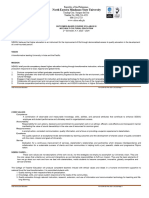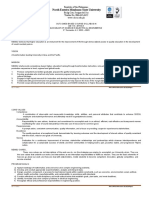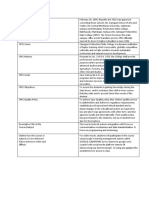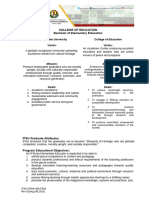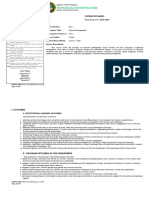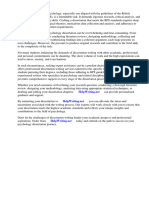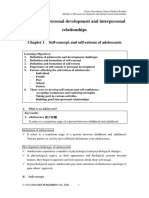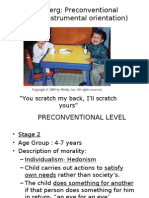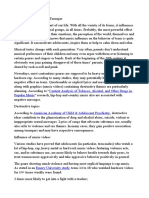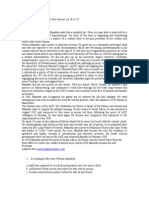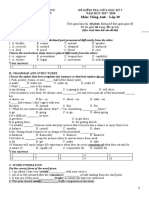Elective - 2 Ege 312 - Gender & Society
Elective - 2 Ege 312 - Gender & Society
Uploaded by
Winnona Oberez GoCopyright:
Available Formats
Elective - 2 Ege 312 - Gender & Society
Elective - 2 Ege 312 - Gender & Society
Uploaded by
Winnona Oberez GoOriginal Title
Copyright
Available Formats
Share this document
Did you find this document useful?
Is this content inappropriate?
Copyright:
Available Formats
Elective - 2 Ege 312 - Gender & Society
Elective - 2 Ege 312 - Gender & Society
Uploaded by
Winnona Oberez GoCopyright:
Available Formats
Republic of the Philippines
North Eastern Mindanao State University
Bislig City, Surigao del Sur
Telefax No. 086-645-6452
www.sdssu.edu.ph
OUTCOMES-BASED COURSE SYLLABUS IN
EGE 312: GENERAL EDUCATION ELECTIVE 2
(GENDER & SOCIETY)
BACHELOR OF SCIENCE IN MECHANICAL ENGINEERING
2nd Semester, A.Y. 2022 – 2023
PHILOSOPHY
NEMSU believes that higher education is an instrument for the improvement of life through democratized access to quality education in the development
of a well-rounded person.
VISION
A transformative leading University in Asia and the Pacific.
MISSION
NEMSU shall provide competency-based higher education training through transformative instruction, relevant research, sustainable extension and
production responsive to local, regional and global trends.
1. Produce competent and skilled graduates prepared for gainful employment;
2. Develop graduates who shall not only foster economic progress but also care for the environment, adhere to positive value system, and preserve
cultural heritage;
3. Engage in high-impact research for instruction and develop technology for food security and renewable energy;
4. Collaborate with government and non-government agencies to help improve the lives of the marginalized groups; and
EGE 312: ELECTIVE 2 Gender & Society FM-CURR-001/Rev.003/1.26.2023/Page 1
5. Promote cooperation/partnership among regional, national, and ASEAN institutions in Higher Education.
CORE VALUES
Competence
A combination of observable and measurable knowledge, skills, abilities, and personal attributes that contribute to enhance SDSSU employee
and student performance and ultimately result in organizational success.
Accountability
Responsibility for own actions, decisions and commitment to accomplish work in an ethical, efficient, cost-effective and transparent manner
manifesting the value of sound stewardship in the wise use of resources for common good.
Responsiveness
A prompt action, consistent communication, quality information, and a focus on providing a superior experience to stakeholders.
Excellence
The quality spectrum at exceptional levels demonstrated by learning outcomes and the development of shared culture of quality consistent
with the vision, mission and goals of University.
Service
Dedication for a continuous improvement of services, stakeholder’s relationships and partnership which stresses interdependence and
collaboration for a sustainable success of clients and their communities in helping build a just, peaceful, stable and progressive Filipino nation.
NEMSU CARES…
These core values are not descriptions of the work we do, nor the strategies we employ to accomplish our University vision. They are the
core values that underlie our works and interactions as we internalize responsibilities to fulfil our mission. They are the basic elements of how we
go about our work and how we deal with stakeholders, molds students to become competent, innovative, globally competitive and service-
oriented.
PROGRAM GOALS:
1. To deliver a globally adaptable system of instructions with enhanced ability to acquire advances in engineering and its allied field.
2. To be self-reliant through effective and efficient generation, allocation and utilization of resources on avenues that advocates the great welfare of
the local and global communities prepared to respond to the emerging trends.
3. To promote advances in research developments that extends sustainable practical solutions to the challenges of engineering and industrial fields
benefiting the socio-economic and environmental growth of the local and global communities prepared to respond to the emerging trends.
EGE 312: ELECTIVE 2 Gender & Society FM-CURR-001/Rev.003/1.26.2023/Page 2
PROGRAM INTENDED LEARNING OUTCOMES:
Graduated of BSME Program should be able to:
1. Apply knowledge of mathematics and science to solve complex mechanical engineering problems.
2. Design and conduct experiments, as well as to analyze and interpret data.
3. Design a system, component, or process to meet desired needs within realistic constraints, in accordance with standards.
4. Function in multidisciplinary multi-cultural teams.
5. Identify, formulate, and solve complex mechanical engineering problems.
6. Understand professional and ethical responsibility.
7. Communicate effectively
8. Understand the impact of mechanical engineering solutions in a global, economic, environmental, and societal context.
9. Recognize the need, the need for, and engage in life-long learning
10. Knows contemporary issues
11. Use techniques, skills, and modern engineering tools necessary for mechanical engineering practice.
12. Know and understand engineering and management principles as a member and leader of the team, and to manage projects in a multidisciplinary
environment.
COURSE CODE : EGE 312
COURSE DESCRIPTIVE TITLE : Elective 2 Gender & Society
COURSE PRE-REQUISITE : None
CREDIT UNITS :3 Units
NO. OF HOURS :54 Hours
COURSE DESCRIPTION :
This course introduces students to human sexuality, gender studies, and other related courses. It surveys various methodological, theoretical, and
practical orientations in gender and sexuality. Using the human ecological lens, it approaches to gender and sexuality from a transdisciplinary stance and
allows learners to understand social realities using multiple disciplinal perspectives, e.g., biomedical, political-legal, and psychological-sociocultural. Most
essentially, it equips learners with the competencies required in investigating and analyzing cross-cutting issues in gender and society.
EGE 312: ELECTIVE 2 Gender & Society FM-CURR-001/Rev.003/1.26.2023/Page 3
COURSE LEARNING OUTCOMES:
At the end of the course, the students should be able to:
Knowledge
1. Differentiate sex, gender and sexuality;
2. Discuss the anatomy and physiology of reproduction;
3. Explain the process of reproduction;
4. Enumerate some psycho-social issues in gender and sexuality; and
5. Enumerate the cross-cutting issues in gender and development.
Skills
1. Translate gender-specific terms into gender-neutral terms;
2. Identify how language discriminates women and LGBTQIA+++;
3. Apply gender-fair language; and
4. Create a case study related to gender and society.
Values
1. Appreciate the strengths and weaknesses of men and women; and
2. Respect the rights of women
EGE 312: ELECTIVE 2 Gender & Society FM-CURR-001/Rev.003/1.26.2023/Page 4
Detailed Course Syllabus Matrix
Time Course Learning Outcomes Topics/Content Instructional Methodology Assessment Remarks
Frame
Class Orientation • Orientation of the *Orientation of the Course
Course: Reflective Essay
a. Discuss the scope of the
course - Course syllabus
b. Establish the connection of - Grading System
*Watching videos or video Journaling
this course to the attainment of - Course clips related to the topics for
learning program outcomes, performance analysis and reflection
Philosophy, VMGO, CORE indicators Reading Log
Week 1 Values & SDSSU Hymn. - Class/course
c. Discuss the school/class policy *Oral Presentation
policies, course requirements, • Introduction and
and grading system. *Interactive discussion of the
Overview of the topics.
d. Familiarize the scope of the
Course
course Gender and Society
e. Create a Concept Map on the
connection of the course to the
University VMGO.
a. Differentiate gender from Module 1: Gender and ➢ Video Presentation (Clip) ➢ Quiz
sexuality Sexuality as a Social ➢ Online Sharing/ ➢ Module 1
b. Explain gender socialization Reality PowerPoint Presentation ➢ Oral Recitation
c. Identify gender stereotypes A. Sex, Gender, ➢ Lecture/ Discussion Poster Board (Collage)
Week 2-3 and the problem stereotyping and Sexuality ➢ Textual Analysis Rubrics
brings B. Gender and ➢ Small Group Discussion
d. Analyze the sexual orientation Sexuality
Poster Board (Collage)
and gender identity and Across Time
Presentation
expression
EGE 312: ELECTIVE 2 Gender & Society FM-CURR-001/Rev.003/1.26.2023/Page 5
C. Gender and
Sexuality as a
subject of
inquiry
a. Differentiate the female, and the I. Module 2: ➢ Quiz
male reproductive system; Biomedical ➢ Lecture / Discussion ➢ Module 2
b. Analyze the basis for Perspective in ➢ Small Group Discussion Rubrics for Reporting
physiological processes in Gender and ➢ Reporting
females and males Sensitivity
Week 4
B. Anatomy and
Physiology of
Reproduction (The
Biological Female and
Male)
a. Define fertilization, conception, A. The Process of ➢ Quescussion Interview Session
and pregnancy/ Reproduction
b. Identify the complications of B. Sexual Health ➢ Think-Pair Share *Interview at least three
early pregnancy in the growing and Hygiene adolescent individuals
adolescent; C. Risky ➢ Individual topic and ask how did they
c. Identify the important health Behaviors and presentation develop their adolescent
Week 5 habits for the developing Adolescents behavior and how did they
adolescent; avoid risky ones.
d. Identify trouble signs that can
lead to risky behaviors and their
complications, and;
e. Discuss how to avoid risky
behaviors.
a. Define the term psychosocial, II. Module 3: ➢ Discussion Board on ➢ Group Debate
and discuss the psychosocial Psychosocial Psychosocial 1. Is it necessary to
Week 6-7 dimension of gender and Perspective in Perspective in choose your circle?
sexuality; Gender and Gender and Sexuality
Sexuality
EGE 312: ELECTIVE 2 Gender & Society FM-CURR-001/Rev.003/1.26.2023/Page 6
b. Define terms such as love, A. Gender and ➢ Picture Tell Analysis 2. When Should be the
attraction, intimacy, Sexuality as a right time to engage in an
relationship, and other related Psychosocial intimate relationship?
terms; Issue
c. Identify needs, issues, and B. Love, Intimacy, ➢ Reflective Essay
concerns experienced by the and How important it is to
people who are in a romantic Relationship know and be equipped
relationship; C. Gender-fair with gender-fair language
d. Identify the ways language Language: and stereotypes?
discriminates against women stereotype,
and LGBTQIA+++; prejudice, and
e. Explain how gender-fair discrimination
language can be realized, and;
f. State forms of discrimination in
language
Week 8 MIDTERM EXAMINATION
a. Discuss LGBTQIA+++ history ➢ LGBTQIA+++ ➢ Discussion Board on ➢ Quiz
and define relevant terms; Psychology LGBTQIA+++ ➢ Paired Written
b. Identify the themes of ➢ Men and Psychology; Men and Reflection
masculinity and its relationship Masculinities Masculinities
Week 9-10 with well-being, fathering, and ➢ Quescussion
domestic roles, and; ➢ Scenario Analysis
c. Comprehend hegemonic,
protest, and caring
masculinities
a. Determine the relationship III. Module 4: Political- ➢ Lecture / Discussion ➢ Quiz
between human rights and Legal Perspective ➢ Small Group ➢ Module 3
gender-based violence; in gender and Discussion Reporting Rubrics for Reporting
Week 11-12 sexuality
b. Differentiate perpetrators, A. Gender-based
survivors, and victims in Violence
gender-based violence;
EGE 312: ELECTIVE 2 Gender & Society FM-CURR-001/Rev.003/1.26.2023/Page 7
c. Identify the various rights of B. Women,
women; Development,
d. Evaluate the impact of this and the World
law and rights on Filipino C. Women and
women and society the Law
e. Discuss the important D. Violence
provisions of VAWC act or Against
RA 9262, and; Women and
f. Analyze actual cases their Children
involving the said law. Act (RA No.
9262)
a. Determine the various A. Laws and ➢ Sharing of personal ➢ Quiz; and
Philippine Laws and Policies Policies on insights about the
for the protection of rights of Violence and common ➢ Create a two-minute
members of LGBTQIA+++; Discrimination discrimination of informative short
b. Identify the different Anti- of the members LGBTQIA++ video to address
Discriminatory Laws and of members, and how these human rights
Policies LGBTQIA+++; did society respond violations and
c. Distinguish the theoretical to it discrimination on the
Week 13-14
perspectives on Sexual B. Discrimination ➢ Discussion board on basis of SOGIE
Harassment in the academe on the Basis of LGBTQIA+++ laws,
and in the workplace, and; SOGIE in the policies, and societal
d. Create a two-minute Philippines; challenges
informative short video to ➢ Quescussion
address these human rights C. Understanding
violations and discrimination Sexual
on the basis of SOGIE Harassment
a. Discuss the importance of Unit 5: Cross-cutting ➢ Strips of paper
media representation; Issues in Gender and identification activity
b. Analyze the progress in media Sexuality (identify statements
Week 15
representation of gender; whether it is a
A. Gender and challenge or a
Media response)
EGE 312: ELECTIVE 2 Gender & Society FM-CURR-001/Rev.003/1.26.2023/Page 8
c. Describe the challenges Education, ➢ Discussion board on
women face in various sectors Health, and Cross-cutting Issues
in the Philippines Mental Health in Gender and
d. Identify the intersectionality Sexuality
between gender, education, ➢ Quescussion
and health
a. Create Research-based Summary of the lesson Research-based Multimodal
Multimodal Output (Short Film Output (Short Film /
/ Documentary) of either Documentary
Week 16-17
Women, or any gender
challenges and how they rise
from it.
Week 18 FINAL EXAMINATION
COURSE REFERENCES:
1. Rodriguez, A.M. & Rodriguez, A.M.L. 2019. Gender and Society: The Whys of Women, Their Oppressions, and Paths to Liberation. Quezon City: C & E
Publishing, Inc.
2. Botor, Nephtaly Joel et al. P.K.R. (2018).“Gender and Society: A Human Ecological Approach Manila, Philippines: Rex Bookstore, Inc.
3. Enloe, Cynthia H. “Bananas, beaches and bases: Making Feminist Sense of International Politics.” 1st ed. Berkeley: University of California Press.
C1990
4. Wood, Julia T. “Gendered Lives: Communication, Gender and Culture.” 11th ed. Stanford CT: Cengage Learning, c2015.
Websites:
1. https://tinyurl.com/y2kt8n8m
2. https://tinyurl.com/yarradcc
3. https://opentextbc.ca/introductiontosociology/chapter/chapter12-gender-sex-and-sexuality/
4. https://tinyurl.com/yxcwbbvf
5. https://tinyurl.com/y3z3hy6w
6. https://tinyurl.com/y27fvamp
7. https://tinyurl.com/wbxhlve
8. https://tinyurl.com/y58kakmr
9. https://tinyurl.com/yy7p24oh
10. http://www.columbia.edu/itc/hs/pubhealth/modules/reproductiveHealth/anatomy.html
EGE 312: ELECTIVE 2 Gender & Society FM-CURR-001/Rev.003/1.26.2023/Page 9
11. https://www.doh.gov.ph/sites/default/files/publications/AdolescentJobAidManualFA.pdf
12. https://www.simplypsychology.org/prejudice.html
13. https://openknowledgemaps.org/search_api/server/paper_preview/3c434709c89b6db5ba346cc9d878b04736361d9329e219d9e2361b7
55f8a5972.PDF
14. https://www.theguardian.com/news/2018/jun/22/the-age-of-patriarchy-how-an-unfashionable-idea-became-a-rallying-cry-for-feminism-
today
15. http://fcs.sites.mjc.edu/109EcologicalModelofHumanDevHandout.pdf
https://www.lawphil.net/judjuris/juri2010/mar2010/gr_169449_2010.html
GRADING SYSTEM:
Class Standing - 40%
Examination - 40%
Requirements - 20%
TOTAL - 100%
Short Fil Making Rubric
Criteria 100 90 80
Three-Act Story Structure The story structure is organized into three acts The story structure is organized There is an attempt to organize
(beginning, middle, and/or end), all ideas are into three acts (beginning, middle, the story in three acts, but a
clearly connected, and there is an obvious and/or end), but not all ideas are beginning, middle, and/or end
introduction and resolution/conclusion. clearly connected cannot be clearly identified.
Connection or ideas are
somewhat disjointed.
Copyright Understanding of copyright is evident, follows fair There are some issues related to Several issues related to
use guidelines, and images/audio are properly copyright, that may include use of copyright are evident, which
credited non-fair use audio or images may include use of non-fair use
and/or not providing proper credit. audio and images, and doesn’t
always provide credit for
sources
EGE 312: ELECTIVE 2 Gender & Society FM-CURR-001/Rev.003/1.26.2023/Page 10
Cinematography Excellent composition; camera movement is Good composition; camera Minimally acceptable
smooth; use of lighting is effective; uses a variety movement is smooth; use of composition; camera movement
of effective shots lighting is good; uses some variety is erratic; lighting quality is
of effective shots but lacks problematic; uses little variety in
consistency shots
Creativity Film shows evidence of imagination and Film shows some evidence of Film shows little evidence of
creativity. There is thoughtfulness to the style and imagination and creativity. There imagination and creativity.
mood that suits the film. is thoughtfulness to the style and There is minimal thoughtfulness
mood that suits the film. to the style and mood that suits
the film.
Teamwork (Production There is not a clear distribution or understanding Production roles are defined, but Production roles are clearly
Roles) of production roles. Filmmaking cues (quiet on not always followed. Fair defined and followed. All group
the set, etc.) are not used to help manage distribution of work is somewhat members have a role in
production. accomplished. Filmmaking cues production. Filmmaking cues
(quiet on the set, etc.) are used (quiet on the set, etc.) are used
most of the time. to manage production.
Date of Revision : January 19, 2023
Date of Effectivity : January 30, 2023
EGE 312: ELECTIVE 2 Gender & Society FM-CURR-001/Rev.003/1.26.2023/Page 11
Prepared by: Content Noted:
QUEENIELYN L. CAJEGAS MYRNA T. ALFEREZ
Instructor GE Program Coordinator
Date: January 19, 2023 Date: ___________
Reviewed by:
ADAM C. MACAPILI
Department Chair
Date: __________
Recommending Approval:
ROMEO A. PATAN, PhD
College of Arts and Sciences Dean
Date: ____________
Approved by:
MARIA LADY SOL A. SUAZO, PhD
Vice President for Academic Affairs
Date: __________
EGE 312: ELECTIVE 2 Gender & Society FM-CURR-001/Rev.003/1.26.2023/Page 12
You might also like
- Motivational Interviewing For School Counselors by Reagan NorthDocument111 pagesMotivational Interviewing For School Counselors by Reagan NorthVu Hd100% (7)
- GE 217 Science Technology and SocietyDocument9 pagesGE 217 Science Technology and SocietyCheryl RanocoNo ratings yet
- Educ 10 Final SyllabusDocument11 pagesEduc 10 Final SyllabusBeverly Love RebusoraNo ratings yet
- MCE SyllabusDocument10 pagesMCE SyllabusGezelle GemaoNo ratings yet
- EthicsDocument14 pagesEthicsWinnona Oberez GoNo ratings yet
- STS SyllabusDocument17 pagesSTS SyllabusgpgawatNo ratings yet
- Syllabus Bsa 1aDocument18 pagesSyllabus Bsa 1aRezia LustriaNo ratings yet
- Understanding TSDocument12 pagesUnderstanding TSwinnona oberezNo ratings yet
- School of Graduate Studies: Republic of The Philippines Sorsogon State College Sorsogon CityDocument5 pagesSchool of Graduate Studies: Republic of The Philippines Sorsogon State College Sorsogon Citymj piersonNo ratings yet
- HEE106 Clothing Selection Purchase and Care2Document7 pagesHEE106 Clothing Selection Purchase and Care2anjo bendanilloNo ratings yet
- Curriculum Development 1stsem 2019-2020Document9 pagesCurriculum Development 1stsem 2019-2020Maria Xari Gutierrez SalinasNo ratings yet
- Syllabus in Ethics - BSED AY 2020-2021 20-2Document11 pagesSyllabus in Ethics - BSED AY 2020-2021 20-2Xeline Mae IdealNo ratings yet
- Syllabus in Ethics - BSED AY 2020-2021 20-2Document11 pagesSyllabus in Ethics - BSED AY 2020-2021 20-2FrancisNo ratings yet
- Pamantasan NG Cabuyao College of Education Arts and SciencesDocument98 pagesPamantasan NG Cabuyao College of Education Arts and SciencesRalph NavelinoNo ratings yet
- Guide BookDocument14 pagesGuide BookJunjun CasanoNo ratings yet
- College of Social Science Teacher Education Program (Beed and Bsed) Obe Course SyllabusDocument7 pagesCollege of Social Science Teacher Education Program (Beed and Bsed) Obe Course SyllabusBjorn AbuboNo ratings yet
- learning plan physicalDocument7 pageslearning plan physicalAndrea Amor DimalibotNo ratings yet
- Understanding The Self SyllabusDocument12 pagesUnderstanding The Self SyllabusCharityOriaNo ratings yet
- Understanding The Self SyllabusDocument12 pagesUnderstanding The Self SyllabusCharityOriaNo ratings yet
- Print SyllabiDocument80 pagesPrint SyllabiDhena H Rasul SabdulaNo ratings yet
- OBE Syllabus Family and Consumer Life SkillsDocument10 pagesOBE Syllabus Family and Consumer Life SkillsbongbongdrrgobrrrNo ratings yet
- Syllabus in Elective 1 - Teaching Multigrade ClassesDocument17 pagesSyllabus in Elective 1 - Teaching Multigrade ClassesFreshie Pasco100% (2)
- Cultures in Mindanao SyllabusDocument9 pagesCultures in Mindanao SyllabusCharityOria100% (1)
- Socio-Cultural Anthropology SyllabusDocument9 pagesSocio-Cultural Anthropology SyllabuskhannyytacadenaNo ratings yet
- 301 Syllabus Assessment of LearningDocument11 pages301 Syllabus Assessment of LearningEmerson Cruz100% (2)
- DocumentDocument4 pagesDocumentJenecel JamitoNo ratings yet
- SOC WORK 2 Environment OBEDocument8 pagesSOC WORK 2 Environment OBETitser DengNo ratings yet
- 2022 SPEAR 203 Syllabus Curriculum Development No SignatureDocument15 pages2022 SPEAR 203 Syllabus Curriculum Development No SignatureMara CuyaNo ratings yet
- Institute of Education, Arts and Sciences First Semester, A.Y. 2020 - 2021 Outcomes - Based Teaching and Learning Plan in EthicsDocument16 pagesInstitute of Education, Arts and Sciences First Semester, A.Y. 2020 - 2021 Outcomes - Based Teaching and Learning Plan in EthicsEila Roshame Pineda100% (1)
- Electrical Wiring System and Design FinalDocument9 pagesElectrical Wiring System and Design Finalmelecio.franzontNo ratings yet
- GEC US Syllabus 2021 2022 UpdatedDocument8 pagesGEC US Syllabus 2021 2022 UpdatedKathleen Anne Bataluna RebanalNo ratings yet
- NSTPDocument10 pagesNSTPHilda DagyoNo ratings yet
- Financial ManagementDocument9 pagesFinancial ManagementMiral CatubingNo ratings yet
- GEC 3 Mathematics in The Modern World For BSEDocument11 pagesGEC 3 Mathematics in The Modern World For BSERochelle Ico SanchezNo ratings yet
- Bsed Gec 108 Course SyllabusDocument9 pagesBsed Gec 108 Course Syllabusjanestephanie181No ratings yet
- New Syllabus Organic and Inorganic Chemistry Graduate SchoolDocument13 pagesNew Syllabus Organic and Inorganic Chemistry Graduate SchoolDarlyn BecinaNo ratings yet
- Educ 2 (BSED) - New TemplateDocument15 pagesEduc 2 (BSED) - New TemplateCarl Martin EngcoyNo ratings yet
- Math 133 SyllabusDocument5 pagesMath 133 SyllabusJim TomoricNo ratings yet
- Southern Leyte State University-Tomas Oppus: WWW - Slsu-Online - Edu.phDocument14 pagesSouthern Leyte State University-Tomas Oppus: WWW - Slsu-Online - Edu.phErna Mae AlajasNo ratings yet
- GE 2 Purposive CommDocument14 pagesGE 2 Purposive Comm4jdnxy7r9yNo ratings yet
- GEE2 People and Earths Ecosystem. SyllabusDocument14 pagesGEE2 People and Earths Ecosystem. SyllabusNerisa LanozaNo ratings yet
- Topics For Reporting V1 Feb 29 2024 1 FINALDocument9 pagesTopics For Reporting V1 Feb 29 2024 1 FINALMirine Grace RicoNo ratings yet
- Taculing Campus, (034) 707-7469, Sum-Ag Campus, (034) 704-5843, Fortune Towne Campus, (034) 704-5844 Tel #: (034) 707-7469Document4 pagesTaculing Campus, (034) 707-7469, Sum-Ag Campus, (034) 704-5843, Fortune Towne Campus, (034) 704-5844 Tel #: (034) 707-7469Melito SamodioNo ratings yet
- ED 1 - The Teacher & The Community, School Culture and Organizational LeadershipDocument10 pagesED 1 - The Teacher & The Community, School Culture and Organizational Leadershipjas37004No ratings yet
- Personality Development and Social Graces SyllabusDocument7 pagesPersonality Development and Social Graces Syllabusleila b. gomultimNo ratings yet
- Comp 1202 Animation PQF l5Document9 pagesComp 1202 Animation PQF l5Ken ZoNo ratings yet
- Major 6 - Syallbus (Curriculum Development in Agricultural Education)Document7 pagesMajor 6 - Syallbus (Curriculum Development in Agricultural Education)Roger Yatan Ibañez Jr.No ratings yet
- Educ 203 (Curricullum Principles, Design Adn Evaluation)Document9 pagesEduc 203 (Curricullum Principles, Design Adn Evaluation)Joellen Mae LayloNo ratings yet
- Maed 302 Current Issues and Problems in EducationDocument8 pagesMaed 302 Current Issues and Problems in EducationJhoe ExoraNo ratings yet
- EDUCADO Course Syllabus TTL BEEdDocument14 pagesEDUCADO Course Syllabus TTL BEEdJoseph Gabriel Educado100% (1)
- FSC 401 Obsvr & PartDocument8 pagesFSC 401 Obsvr & PartPaz Macanas-belenoNo ratings yet
- Mctle2 He Lit Syllabus KDocument8 pagesMctle2 He Lit Syllabus KReñon Shielou NimoNo ratings yet
- Local Media2381286157614080542Document13 pagesLocal Media2381286157614080542Junie carla GazaNo ratings yet
- GEC 11 SYLLABUS Gender and Society 2024 25Document22 pagesGEC 11 SYLLABUS Gender and Society 2024 25joylynguerrero79No ratings yet
- PUPSPC - SYLLABUS - ASSESSMENT IN LEARNING 2 RevisedDocument16 pagesPUPSPC - SYLLABUS - ASSESSMENT IN LEARNING 2 RevisedCristopher E. Catchillar Jr.No ratings yet
- (Foundation of Inclusive and Special EducationDocument9 pages(Foundation of Inclusive and Special EducationROBERT REJUSONo ratings yet
- Sultan Kudarat State UniversityDocument10 pagesSultan Kudarat State UniversitySnyrah AmbagNo ratings yet
- Pe 103 Prelim Module BsbaDocument41 pagesPe 103 Prelim Module BsbaCesar Verden AbellarNo ratings yet
- Elec MHE212Document7 pagesElec MHE212Ramonito TanNo ratings yet
- 011 PR MA 2021 Syllabus Template Flexible LearningDocument11 pages011 PR MA 2021 Syllabus Template Flexible LearningJonathan LipitinNo ratings yet
- Teaching College-Level Disciplinary Literacy: Strategies and Practices in STEM and Professional StudiesFrom EverandTeaching College-Level Disciplinary Literacy: Strategies and Practices in STEM and Professional StudiesJuanita C. ButNo ratings yet
- Psychology Dissertation BpsDocument7 pagesPsychology Dissertation BpsWriteMyPaperReviewsOverlandPark100% (1)
- Every Teen Girl's Lttle Pink BookDocument96 pagesEvery Teen Girl's Lttle Pink BookgeorgetacaprarescuNo ratings yet
- Teaching Notes: Blood Brothers by Willy RussellDocument15 pagesTeaching Notes: Blood Brothers by Willy RussellkatyNo ratings yet
- Adolescents' Life Satisfaction: The Role of Classroom, Family, Self-Concept and GenderDocument12 pagesAdolescents' Life Satisfaction: The Role of Classroom, Family, Self-Concept and GenderUmdatul KhoirotNo ratings yet
- A Psychological Perspective of Divorce Among Muslim Community in Sri LankaDocument12 pagesA Psychological Perspective of Divorce Among Muslim Community in Sri LankaTwinkle RajpalNo ratings yet
- Early Adolescence (Ages 10 To 13) : Females MalesDocument5 pagesEarly Adolescence (Ages 10 To 13) : Females MalesBea Valerie GrislerNo ratings yet
- Ethics & Issues in CounsellingDocument5 pagesEthics & Issues in Counsellingakmaliqbal275No ratings yet
- Review of The LiteratureDocument13 pagesReview of The Literatureslytle23No ratings yet
- Prevalence of Anemia Among Adolescent GirlsDocument6 pagesPrevalence of Anemia Among Adolescent GirlsYolanda SimamoraNo ratings yet
- (Module1) Personal Development and Interpersonal RelationshipsDocument27 pages(Module1) Personal Development and Interpersonal RelationshipsLai Chuen ChanNo ratings yet
- Children of AlcoholicsDocument36 pagesChildren of AlcoholicsAldo Realized Garcia100% (2)
- Child and Adolescent Development COUN F628 Online CourseDocument24 pagesChild and Adolescent Development COUN F628 Online CourseLovely GracieNo ratings yet
- Multiple Domains of DevelopmentDocument9 pagesMultiple Domains of DevelopmentJessica FornoNo ratings yet
- Theories of Growth and Development 2Document51 pagesTheories of Growth and Development 2MarchellayNo ratings yet
- List of Eligible Teachers For Promotion Panel As B.T. Assistants (Science) As On 01-01-2014Document5 pagesList of Eligible Teachers For Promotion Panel As B.T. Assistants (Science) As On 01-01-2014edwin_prakash75No ratings yet
- UFSC 2006 1 AmarelaDocument16 pagesUFSC 2006 1 AmarelaRafael Ubirajara Rocha FerreiraNo ratings yet
- The Role of Stigmatizing Experiences MILKEWICZ ANNIS CASH HRABOSKYDocument13 pagesThe Role of Stigmatizing Experiences MILKEWICZ ANNIS CASH HRABOSKYGonzalo PaezNo ratings yet
- Pediatric Healthcare ToolkitDocument48 pagesPediatric Healthcare ToolkitJesse M. Massie100% (1)
- How Does Music Affect TeenagerDocument3 pagesHow Does Music Affect TeenagerRina DzhuraNo ratings yet
- Reading Test B1Document5 pagesReading Test B1unutulmazNo ratings yet
- CHN Family Developmental StagesDocument12 pagesCHN Family Developmental StagesRyll JohnsonNo ratings yet
- What Is Developmental PsychologyDocument9 pagesWhat Is Developmental PsychologyI Luh Tika Sulesa WitriNo ratings yet
- Socialization EssayDocument3 pagesSocialization EssayLydia100% (1)
- Final Critical Analysis Paper of The Representative (SC)Document8 pagesFinal Critical Analysis Paper of The Representative (SC)ernesto cruzNo ratings yet
- Factors Related To Drop Outs and Performance Ofcwts Students at Laguna State Polytechnic University San Pablo City Campus Academic Year 2010Document35 pagesFactors Related To Drop Outs and Performance Ofcwts Students at Laguna State Polytechnic University San Pablo City Campus Academic Year 2010Ian Adrian Garcia50% (2)
- LocDocument51 pagesLoctraghav2006No ratings yet
- Your answers: Môn: Tiếng Anh - Lớp 10Document11 pagesYour answers: Môn: Tiếng Anh - Lớp 10Nguyễn Vân AnhNo ratings yet
- Efficacy of A Primary Care Mental Health Program For Victims of The Armed Conflict in ColombiaDocument16 pagesEfficacy of A Primary Care Mental Health Program For Victims of The Armed Conflict in ColombiaLuisa SantiagaNo ratings yet
- Dpe 105 - Group 1Document80 pagesDpe 105 - Group 1Chastine Delirio AmparoNo ratings yet



